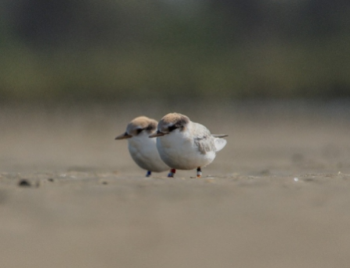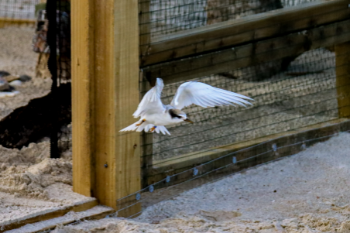
MANGAWHAI'S NO.1 NEWSPAPER
|
|
|
Successful breeding season for one of our rarest birdsO4 March, 2022
With fewer than 40 adult birds, the conservation status of tara iti is Nationally Critical. Despite extensive management, the population has teetered on the brink of extinction since the 1970s. This season has been successful because of ongoing management of the birds and their habitats, strong support from volunteers and the wider community, new intensive management techniques from Auckland Zoo, and periods of settled weather. The Department of Conservation (DOC), alongside iwi and key stakeholders, have been developing a new recovery strategy for tara iti over the past few years. This plan includes management of the vegetation, sand, and shell at site to improve the quality of tara iti habitats, and identifying and managing new sites for the birds. This is married with ongoing predator control, artificial incubation of eggs, and seasonal monitoring by DOC rangers and volunteers. The plan is informed by ongoing research into tara iti fertility, genetics, feeding, and improvements to data and field-based best practices. Adaptive management is an important tool in the tara iti recovery programme. For example, site management designed to prevent tara iti nesting on an exposed area at Mangawhai this season resulted in fewer losses of eggs and chicks than in previous seasons. “By deterring the tara iti from nesting in this undesirable location we’ve seen them move to more stable areas nearby which are well protected from mobile sand during storm events,” says DOC biodiversity ranger Ayla Wiles. “Mangawhai is the most significant breeding site with six breeding pairs, and all bar one of these pairs successfully raised chicks this year.” In addition to their work to develop and implement the recovery plan, DOC and Auckland Zoo have maintained a strong partnership, working together over the past two years to trial raising the birds at the zoo. The programme includes artificially incubating and hatching eggs, and hand-rearing chicks. Despite there being very little experience or information on these techniques for terns, one chick was successfully reared and released in the 2020-2021 season. Building on this success and the knowledge gained from it, Auckland Zoo successfully incubated, hatched and raised tara iti chicks this year. Five chicks were transferred to the specially designed release aviary on a beach where the birds occur naturally – two of which were successfully released, representing 20 percent of the successful fledglings this year. In the aviary, the birds have the opportunity to practice flying and foraging for fish before being released to join the few remaining wild terns. If these trials prove to be successful, then captive rearing may become an invaluable tool for improving numbers of tara iti in Aotearoa-New Zealand. Once widespread around the North Island and on the eastern South Island, tara iti now nest at only four main sites, Papakanui Spit, Pakiri Beach and Waipu and Mangawhai sandspits, and occasionally at a fifth site at Te Arai. Tara iti often make their nests on shell and sand mounds above spring high tide, which leaves them vulnerable to predators, disturbance by people, 4WD vehicles and dogs.
DOC works closely with Patuharakeke, Ngati Wai, Ngati Whatua o Kaipara, Ngati Manuhiri, and Te Uri O Hau, The Shorebirds Trust, The NZ Fairy Tern Charitable Trust, About Tern, Birds NZ, and the Waipu Trapping Group to help protect tara iti. Support for the tara iti season has also been provided by the New Zealand Defence Force, Pakiri Beach Holiday Park, Tara Iti Golf Course, iwi and landowners at Pakiri, Auckland Council, Armourguard and Auckland Zoo.
Mangawhai fledglings exploring at Mangawhai estuary. CREDIT/JACOB BALL
After artificially incubating, hatching, and hand-rearing, chicks practice flying and foraging before leaving their special aviary. PHOTO/SHELLEY OGLE
“Mangawhai is the most significant breeding site with six breeding pairs, and all bar one of these pairs successfully raised chicks this year.” – Ayla Wiles, DOC |

 With eight tara iti/New Zealand fairy tern expected to fledge (leave the nest), it’s been the best breeding season since 2013-2014 for one of Aotearoa New Zealand's rarest birds.
With eight tara iti/New Zealand fairy tern expected to fledge (leave the nest), it’s been the best breeding season since 2013-2014 for one of Aotearoa New Zealand's rarest birds. Since September, a dedicated team of six tara iti DOC rangers and numerous community volunteers have been busy trapping for predators, fencing off nesting sites, and preventing nesting birds from being disturbed by humans. The rangers and volunteers have now finished the intensive stage of work as most chicks have fledged.
Since September, a dedicated team of six tara iti DOC rangers and numerous community volunteers have been busy trapping for predators, fencing off nesting sites, and preventing nesting birds from being disturbed by humans. The rangers and volunteers have now finished the intensive stage of work as most chicks have fledged.
